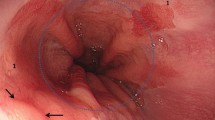Abstract
Background and Aim
Although endoscopic recognition of dysplasia in Barrett’s esophagus is difficult, experience in recognition of early neoplastic lesions is supposed to increase the detection of early neoplastic lesions. The aim of this study was to assess the significance of dysplasia in random biopsies in Barrett’s esophagus, in the absence of reported visible lesions as well as the difference in final outcome of pathology.
Methods
We retrospectively identified all patients with Barrett’s esophagus with suspicion of dysplasia or early adenocarcinoma who were referred to our center between February 2008 and April 2016. We analyzed all endoscopy reports, pathology reports, and referral letters from 19 different hospitals. Patients were divided into two groups, based on the presence or absence of visible lesions reported upon referral.
Results
In total, 170 patients diagnosed with dysplasia or adenocarcinoma were referred to our tertiary center. Ninety-one of these referred patients were referred with dysplasia or adenocarcinoma in random biopsies, without a reported lesion during endoscopy in the referral center. During endoscopic work-up at our center, a visible lesion was detected in 44 of these 91 patients (48.4%). After endoscopic work-up and treatment, adenocarcinoma was found in an additional 21 patients. Two of these patients were initially referred with low-grade dysplasia, and 19 patients were initially referred with high-grade dysplasia. The final pathology was upstaged in 35.8% of the patients.
Conclusions
The presence of any grade of dysplasia in random biopsies during surveillance in referral centers is a marker for more severe final pathology. Training in recognition of early neoplastic lesions in Barrett’s esophagus imaging is recommended for endoscopists performing Barrett’s surveillance.


Similar content being viewed by others
References
Desai TK, Krishnan K, Samala N, et al. The incidence of oesophageal adenocarcinoma in non-dysplastic Barrett’s oesophagus: a meta-analysis. Gut. 2012;61:970–976.
Yousef F, Cardwell C, Cantwell MM, Galway K, Johnston BT, Murray L. The incidence of esophageal cancer and high-grade dysplasia in Barrett’s esophagus: a systematic review and meta-analysis. Am J Epidemiol. 2008;168:237–249.
Verbeek RE, Leenders M, Ten Kate FJ, et al. Surveillance of Barrett’s esophagus and mortality from esophageal adenocarcinoma: a population-based cohort study. Am J Gastroenterol. 2014;109:1215–1222.
Kastelein F, van Olphen SH, Steyerberg EW, Spaander MC, Bruno MJ. Impact of surveillance for Barrett’s oesophagus on tumour stage and survival of patients with neoplastic progression. Gut. 2016;65:548–554.
Weusten B, Bisschops R, Coron E, et al. Endoscopic management of Barrett’s esophagus: European Society of Gastrointestinal Endoscopy (ESGE) position statement. Endoscopy. 2017;49:191–198.
P.D.Siersema, J.J.G.H.M.Bergman, M.I.van Berge Henegouwen, A.van der Gaast, W.Hameeteman, R.van Hillegersberg, et al. Dutch Barrett guideline. 2018.
Cameron GR, Jayasekera CS, Williams R, Macrae FA, Desmond PV, Taylor AC. Detection and staging of esophageal cancers within Barrett’s esophagus is improved by assessment in specialized Barrett’s units. Gastrointest Endosc. 2014;80:971–983.
Scholvinck DW, van der Meulen K, Bergman JJGH, Weusten BLAM. Detection of lesions in dysplastic Barrett’s esophagus by community and expert endoscopists. Endoscopy. 2017;49:113–120.
Bergman JJ, de Groof AJ, Pech O, et al. An interactive web-based educational tool improves detection and delineation of Barrett’s esophagus related neoplasia. Gastroenterology 2019.
Wang KK, Sampliner RE. Updated guidelines 2008 for the diagnosis, surveillance and therapy of Barrett’s esophagus. Am J Gastroenterol. 2008;103:788–797.
Pouw RE, Seewald S, Gondrie JJ, et al. Stepwise radical endoscopic resection for eradication of Barrett’s oesophagus with early neoplasia in a cohort of 169 patients. Gut. 2010;59:1169–1177.
Pech O, Behrens A, May A, et al. Long-term results and risk factor analysis for recurrence after curative endoscopic therapy in 349 patients with high-grade intraepithelial neoplasia and mucosal adenocarcinoma in Barrett’s oesophagus. Gut. 2008;57:1200–1206.
Sharma P, Dent J, Armstrong D, et al. The development and validation of an endoscopic grading system for Barrett’s esophagus: the Prague C & M criteria. Gastroenterology. 2006;131:1392–1399.
Participants in the Paris Workshop. The Paris endoscopic classification of superficial neoplastic lesions: esophagus, stomach, and colon: November 30 to December 1, 2002. Gastrointest Endosc. 2003;58:S3–43.
van der Sommen F, Zinger S, Curvers WL, et al. Computer-aided detection of early neoplastic lesions in Barrett’s esophagus. Endoscopy. 2016;48:617–624.
van der Sommen F, Klomp SR, Swager AF, et al. Predictive features for early cancer detection in Barrett’s esophagus using Volumetric Laser Endomicroscopy. Comput Med Imaging Graph. 2018;67:9–20.
de Groof AJ, Struyvenberg MR, van der PJ, et al. Deep-learning system detects neoplasia in patients with Barrett’s esophagus with higher accuracy than endoscopists in a multi-step training and validation study with benchmarking. Gastroenterology 2019.
Bhandari P. Acetic acid chromoendoscopy in the setting of neoplastic Barrett esophagus. Gastroenterol Hepatol (N Y). 2017;13:508–510.
Author information
Authors and Affiliations
Corresponding author
Ethics declarations
Conflict of interest
The authors declare that there is no conflict of interest.
Additional information
Publisher's Note
Springer Nature remains neutral with regard to jurisdictional claims in published maps and institutional affiliations.
Rights and permissions
About this article
Cite this article
Noordzij, I.C., Van Loon van de Ende, M.C.M., Curvers, W.L. et al. Dysplasia in Random Biopsies from Barrett’s Surveillance Is an Important Marker for More Severe Pathology. Dig Dis Sci 66, 1957–1964 (2021). https://doi.org/10.1007/s10620-020-06463-4
Received:
Accepted:
Published:
Issue Date:
DOI: https://doi.org/10.1007/s10620-020-06463-4




